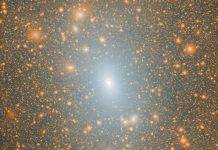
NASA’s James Webb Space Telescope has taken an amazing photo of something called Herbig-Haro 211, or HH 211 for short.
What’s special about it?
Well, HH 211 is a jet of gas shooting out from a very young star at speeds faster than sound! Located in the constellation Perseus, about 1,000 light-years away from Earth, it’s giving us some unique insights into young stars, like what our Sun used to be.
So, what’s a Herbig-Haro object?
They’re glowing areas around brand-new stars. When wind or gas comes out of these baby stars, it crashes into nearby gas and dust and forms shock waves, making the area light up.
HH 211 is particularly interesting because the star at its center is very much like our Sun was when it was only a few tens of thousands of years old. It’s still growing and has only about 8% of the Sun’s current mass.
Why use infrared imaging? Young stars are usually hidden inside the gas and dust from the cloud where they were born. Regular telescopes can’t see through this, but infrared light can!
The James Webb Space Telescope’s powerful infrared camera helps us see these hidden stars and the jets they produce.
When the gas and dust in these jets move around quickly, they light up in the infrared range, which the Webb telescope captures.
The picture Webb took is remarkable. It’s 5 to 10 times clearer than any picture we’ve had of HH 211 before.
We can see bow-shaped shocks in two directions and a narrow jet of gas that powers them. This jet seems to “wiggle” a bit on either side of the star. Scientists think this might mean there are actually two stars at the center, not just one!
Before Webb, other telescopes had shown us some of these features, but not as clearly. They had seen the bow shocks and some wiggling in the jet.
With Webb’s new data, scientists have figured out that HH 211’s jet isn’t moving as fast as some other young stars. They measured its speed to be around 48 to 60 miles per second. That may sound fast, but it’s slow compared to other similar jets.
Why does the speed matter? Well, the speed tells us what the jet is made of. In this case, the jet’s not moving fast enough to break up its molecules.
So, scientists think it’s mostly made of molecules, not just simple atoms or charged particles.
This discovery is a big deal. It helps us understand more about what stars like our Sun were like when they were young.
The more we know about young stars, the more we can understand how our own Sun and solar system came to be.
The research has been published in the scientific journal Nature, which means it’s gone through a lot of checks and is solid science. This is just one example of how the James Webb Space Telescope will help us uncover the universe’s secrets.
So, stay tuned for more exciting news from outer space!



